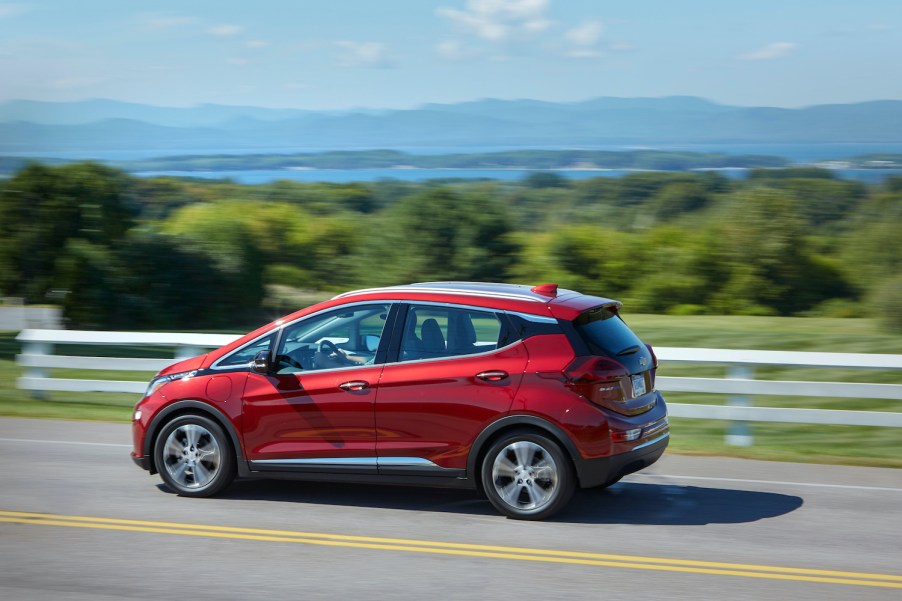
There Are Plenty of Reasons to Avoid the Chevrolet Bolt EV
Electric Vehicles (EVs) have become pretty popular as of late. With the segment’s popularity on the rise, you may even be considering an EV model for yourself. Maybe you already have the Chevrolet Bolt EV on your list too. If you do, wait just a minute because there are several reasons why you should avoid the Chevrolet Bolt EV.

Competitors are catching up to the Bolt EV’s class-leading EPA-estimated range
There’s no denying that the Chevrolet Bolt EV can take you pretty far. Charge it up, and this EV boasts a class-leading EPA-estimated range of 259 miles. For many drivers, that 259 miles is more than enough to get them through the day.
However, it’s worth noting that the Bolt EV’s competitors are catching up. According to Kelley Blue Book, the 2021 Hyundai Kona EV is only one mile short of the Chevrolet Bolt EV. InsideEVs reports that other EVs, including the Kia Niro EV and the Nissan Leaf trail closely behind the Chevrolet Bolt EV too.
Active safety features will cost you extra
If you’re after an EV that comes standard with a long list of active safety features, then the Chevrolet Bolt may not be the right fit for you. While it does come standard with safety features like a rear vision camera and a full suite of airbags, it does not come standard with sought after safety features like lane change alert with side blind zone alert, rear cross-traffic alert, and rear park assist. Instead, these safety features require opting for the Driver Confidence Package.
Compare the Chevrolet Bolt EV’s safety features to the Hyundai Kona EV, and you’ll find that there’s little to no reason the Bolt EV goes without such standard safety features. Whereas the Bolt EV requires an upgrade to gain access to active safety features, vehicles like the Hyundai Kona EV are standard with them.
Consumer Reports called the Bolt EV’s interior “cheap and flimsy”
The interior of the Chevrolet Bolt EV leaves a lot to be desired too. According to Consumer Reports, “It’s clear Chevy saved a few pennies on the Bolt’s interior.” And while it may look modern throughout, those looks are deceiving because, overall, “the materials are rather cheap and flimsy,” says Consumer Reports.
Car and Driver agrees with Consumer Reports’ assessment too. In its test drive of the 2020 Chevrolet Bolt EV, Car and Driver reported that the “quality of the plastics say economy more than premium.” U.S. News & World Report came to a similar conclusion, adding that “Compared to its rivals, however, it has low-quality materials and seats that aren’t very supportive.”
It doesn’t qualify for federal tax credits anymore
For many EV shoppers, what draws them into the segment are the federal tax credits. Can you blame them, though? A $7,500 federal tax incentive is nothing to scoff at, and for many new-car shoppers, it means saving a ton of money on their purchase.
Unfortunately, when it comes to the Chevrolet Bolt EV, that $7,500 federal tax credit is no longer available because the Bolt EV has already exceeded the 200,000-car sales limit. That doesn’t mean you can’t take advantage of state or local tax credits. Chevrolet will likely cut some pretty good deals on it too. Just keep in mind that other vehicles that do still qualify for the federal tax credit may be lower in price than the Bolt EV.
But is the Chevrolet Bolt EV really that bad?
The Chevrolet Bolt EV isn’t a bad car. It’s able to go pretty far on a single charge, which is worth keeping in mind. It’s just that the interior of this EV isn’t that great, and the vehicle itself no longer qualifies for federal tax incentives. If those things aren’t a problem for you, then you might be happy with the Bolt EV. But if you’re after an EV with a meticulously crafted interior that does qualify for that $7,500 incentive? Then you might want to consider another EV altogether.



